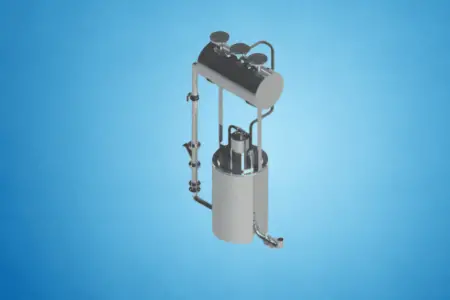Boilers are one of many different methods that people use to heat their homes and keep them warm. Like furnaces and other forms of heat, boilers create condensation as they’re producing heat. Depending on where or how your boiler is installed, you may need a condensate pump attached to it.
A boiler that’s installed in a way that condensation is unable to flow to a drain using only gravity will require a condensate pump. A running boiler produces 2 to 3 liters of condensation per hour, which is enough to flood your basement.
In this article, we’ll look at when you need a condensate pump for your boiler. We’ll also look at different types of condensate pumps as well what happens when you don’t have one. If you have any questions about condensate pumps with your boiler, you’ve come to the right place.
Do I need a condensate pump on my boiler?
Condensate pumps are devices that use centrifugal force to pump water against the force of gravity to a safe place for disposal. Boilers produce lots of condensation when they’re operating, and all of that condensation has to go somewhere.
If your boiler is in a basement without a nearby drain, it’s important that you have a condensate pump. Without one, you’re likely to end up with a flooded basement resulting in mold or water damage. It’s vital that you know whether or not you need a condensate pump before operating your boiler.
Steam Condensate Pump
One type of condensate pump that’s often used with boilers is a steam condensate pump. Steam condensate pumps are designed to reuse condensation produced by the boiler itself. Here’s how it works.
- Your boiler heats up water until it turns into steam, which is lighter than air and floats.
- Because the water turned to steam is now lighter than air, it floats through a series of pipes connected to the boiler.
- The pipes run throughout your home or building, which means that steam is traveling inside of them and heating your home as it goes.
- As the steam cools, it turns into condensation and runs back down the pipes to the boiler.
- A steam condensate pump will then redirect all this extra condensation back to the boiler to be reused and turned into steam once again.
Using a steam condensate pump has several advantages. They will help your boiler system to run as efficiently and smoothly as possible. Steam condensate pumps also save you money by reusing water so that freshwater doesn’t have to be used.
What happens when a condensate pump fails?
If you’ve ever had a condensate pump fail on you, it’s likely that you’ll never forget about it. Because the job of a condensate pump is to take water and dispose of it, one that goes bad will result in big problems. Water will overflow out of the condensate pump reservoir and flood the nearby area. Water damage, mold, and mildew are all possible outcomes of a condensate pump failure.
Let’s look at a few common reasons that condensate pumps fail.
- Electrical problem to the condensate pump.
Most condensate pumps are plug-and-play. As a result, most electrical problems are the result of a tripped breaker or an outlet with faulty wiring. If your condensate pump isn’t running and there isn’t power running to the outlet it’s plugged into, you likely have an electrical problem with your outlet.
- The float in the pump malfunctions.
Inside the reservoir of the condensate pump, there’s a tiny float. As the reservoir fills with water, the float rises to the top and signals the pump that it’s full and needs to drain. If the float gets stuck for some reason and can’t float to the top, your pump won’t know that it’s time to activate and drain the condensation.
- There’s a plug in the condensate line.
Your condensate pump will likely have two pipes or tubes attached to it. The bigger of the two is usually a ½ or ¾ inch PVC pipe that sticks into the reservoir. Water travels out of your boiler, through this pipe, and into the condensate pump.
On the top of the pump on the opposite side of the PVC pipe, there should be a plastic tube. This tube should attach to the top of the condensate pump and run to a floor drain or other safe place to disperse the condensation. If a plug or kink forms in this line, water will be unable to safely travel to a drain, which means that your condensate pump will back up and overflow.
How much does it cost to replace a condensate pump?
Condensate pumps are fairly easy to install and you can likely perform the job yourself. The pump itself costs anywhere from $55 to $100 depending on the brand and motor size. Most condensate pumps have a cord attached to the end, which makes them easy to operate.
To replace your existing condensate pump, simply unplug the old one and detach the PVC pipe going into the reservoir, and the tube attached to the outlet end. Set the old pump aside and put the new pump in its place. Before plugging it in, however, make sure that you reinsert the PVC pipe into the reservoir and reattach the tube to the outlet end. Once you’ve done this, plug your condensate pump in and it should start running automatically.
How long do condensate pumps last?
Most condensate pumps should last a minimum of five years, but there’s always a possibility that they give out prematurely. If you have a condensate pump, you should check it every couple of months, to ensure that it’s working. Checking your condensate pump is especially important if it’s located in an attic or on your main floor. Flooding in these areas are more detrimental than flooding in an unfinished basement.
How often should boiler condensate pump run?
Simply put, a boiler condensate pump will run as often as it needs to in order to keep from overflowing. As the reservoir of the pump fills up, there’s a float that rises to the top that will automatically signal the pump to start running. The more your boiler runs, the more your condensate pump will also run.
Final Thoughts
Condensate pumps are a life-saver when it comes to using your boiler. They allow you to operate your boiler in a basement or wherever is most convenient. Where flooding caused by condensation once made this impossible, condensate pumps have now made it a reality. If you’re concerned about efficiency and saving money, you should also utilize a steam condensate pump.

Nick Lopresti is the founder of YourH2Home and a home improvement expert. He has years of experience writing about various home improvement topics, mostly as it pertains to water systems.
